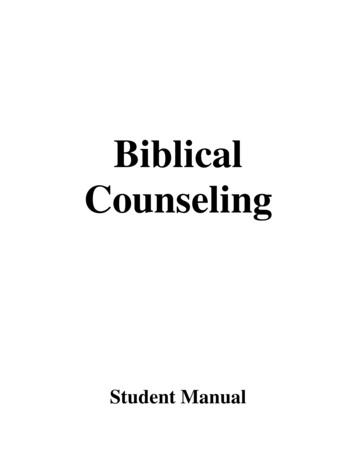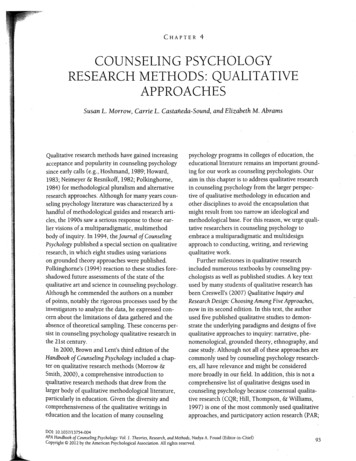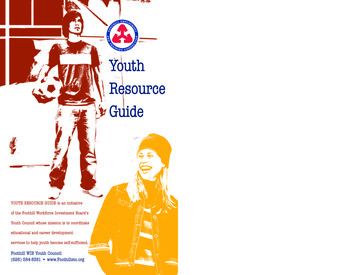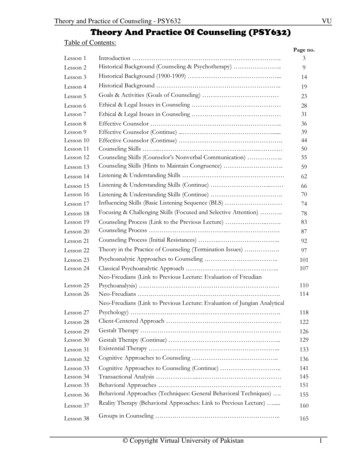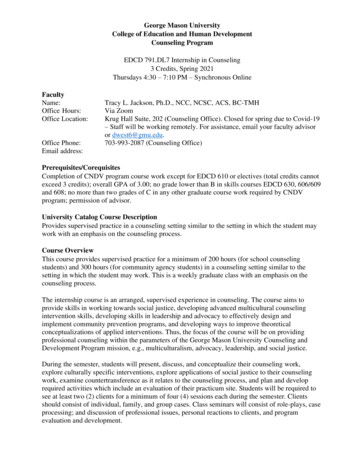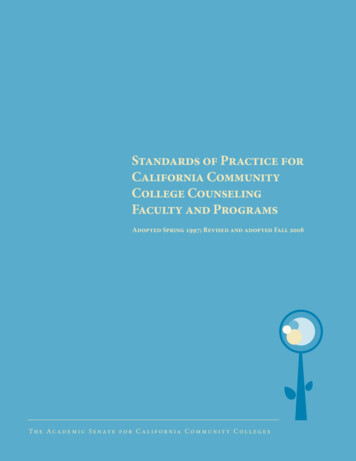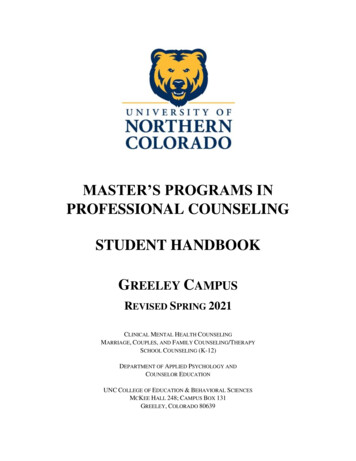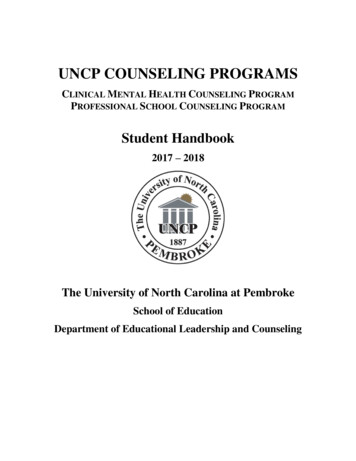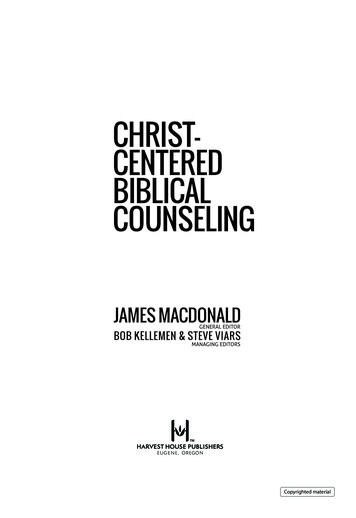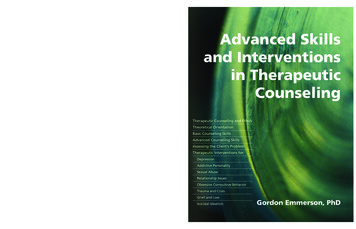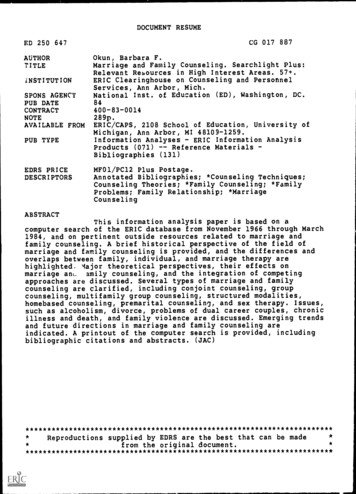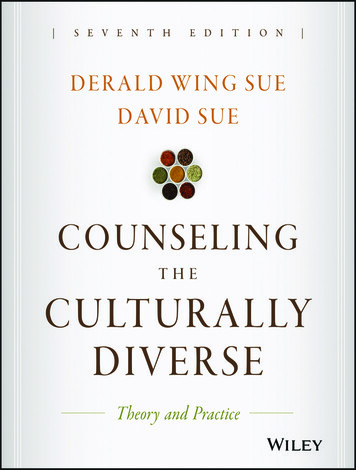
Transcription
Counseling theCulturally Diverse
SEVENTH EDITIONCounseling theCulturally DiverseTheory and PracticeDerald Wing Sue David Sue
This book is printed on acid-free paper.Copyright 2016 by John Wiley & Sons, Inc. All rights reserved.Published by John Wiley & Sons, Inc., Hoboken, New Jersey.Published simultaneously in Canada.No part of this publication may be reproduced, stored in a retrieval system, or transmitted in any form orby any means, electronic, mechanical, photocopying, recording, scanning, or otherwise, except as permittedunder Section 107 or 108 of the 1976 United States Copyright Act, without either the prior writtenpermission of the Publisher, or authorization through payment of the appropriate per-copy fee to theCopyright Clearance Center, Inc., 222 Rosewood Drive, Danvers, MA 01923, (978) 750-8400, fax (978)646-8600, or on the web at www.copyright.com. Requests to the Publisher for permission should be addressedto the Permissions Department, John Wiley & Sons, Inc., 111 River Street, Hoboken, NJ 07030, (201) 748 6011, fax (201) 748-6008.Limit of Liability/Disclaimer of Warranty: While the publisher and author have used their best efforts inpreparing this book, they make no representations or warranties with respect to the accuracy or completenessof the contents of this book and specifically disclaim any implied warranties of merchantability or fitness for aparticular purpose. No warranty may be created or extended by sales representatives or written sales materials.The advice and strategies contained herein may not be suitable for your situation. You should consult with aprofessional where appropriate. Neither the publisher nor author shall be liable for any loss of profit or anyother commercial damages, including but not limited to special, incidental, consequential, or other damages.This publication is designed to provide accurate and authoritative information in regard to the subjectmatter covered. It is sold with the understanding that the publisher is not engaged in rendering professionalservices. If legal, accounting, medical, psychological, or any other expert assistance is required, the services of acompetent professional person should be sought.Designations used by companies to distinguish their products are often claimed as trademarks. In all instanceswhere John Wiley & Sons, Inc. is aware of a claim, the product names appear in initial capital or all capitalletters. Readers, however, should contact the appropriate companies for more complete information regardingtrademarks and registration.For general information on our other products and services please contact our Customer Care Departmentwithin the United States at (800) 762-2974 or outside the United States at (317) 572-3993, or fax (317)572-4002.Wiley publishes in a variety of print and electronic formats and by print-on-demand. Some material includedwith standard print versions of this book may not be included in e-books or in print-on-demand. If this bookrefers to media such as a CD or DVD that is not included in the version you purchased, you may downloadthis material at http://booksupport.wiley.com. For more information about Wiley products, visit www.wiley.com.Library of Congress Cataloging-in-Publication Data:Sue, Derald Wing.Counseling the culturally diverse : theory and practice / Derald Wing Sue, David Sue. – 7th edition.pages cmIncludes bibliographical references and index.ISBN 978-1-119-08430-3 (cloth) – ISBN 978-1-119-08437-2 (pdf ) – ISBN 978-1-119-08433-4 (epub)1. Cross-cultural counseling. I. Sue, David. II. Title.BF637.C6S85 2016158.3–dc232015018013Printed in the United States of America10 9 8 7 6 5 4 3 2 1
ContentsPrefaceAbout the AuthorsxiiixxSECTION ONE The Multiple Dimensions of MulticulturalCounseling and Therapy1PART I The Affective and Conceptual Dimensions of MulticulturalCounseling and Therapy3Chapter 1 Obstacles to Cultural Competence: UnderstandingResistance to Multicultural TrainingReactions to Reading Counseling the Culturally DiverseEmotional Self-Revelations and Fears:Majority Group MembersEmotional Invalidation versus Affirmation:For Marginalized Group MembersRecognizing and Understanding Resistanceto Multicultural TrainingCultural Competence and EmotionsSummaryReferencesChapter 2 The Superordinate Nature of Multicultural Counselingand TherapyCulture-Universal (Etic) versus Culture-Specific (Emic)FormulationsThe Nature of Multicultural Counseling CompetenceA Tripartite Framework for Understanding the MultipleDimensions of IdentityIndividual and Universal Biases in Psychologyand Mental HealthThe Impact of Group Identities on Counselingand PsychotherapyWhat Is Multicultural Counseling/Therapy?5610142029323437414547515354
VICONTENTSWhat Is Cultural Competence?Cultural Humility and Cultural CompetenceSocial Justice and Cultural CompetenceSummaryReferences5661636566Chapter 3 Multicultural Counseling Competence for Counselorsand Therapists of Marginalized GroupsCounselors from Marginalized Groups Working withMajority and Other Marginalized Group ClientsThe Politics of Interethnic and Interracial Bias andDiscriminationThe Historical and Political Relationships betweenGroups of ColorDifferences between Racial/Ethnic GroupsCounselors of Color and Dyadic CombinationsSummaryReferences818587100102PART II The Impact and Social Justice Implications of Counselingand Psychotherapy105Chapter 4 The Political and Social Justice Implications ofCounseling and PsychotherapyImpact of Political OppressionThe Education and Training of Counseling/MentalHealth ProfessionalsDefinitions of Mental HealthCounseling and Mental Health LiteratureThe Need to Treat Social Problems—Social JusticeCounselingThe Foci of Counseling Interventions: Individual,Professional, Organizational, and SocietalSocial Justice CounselingSummaryReferencesChapter 5 The Impact of Systemic Oppression: CounselorCredibility and Client WorldviewsThe Rest of the StoryEffects of Historical and Current 47150
CONTENTSChapter 6Counselor Credibility and AttractivenessFormation of Individual and Systemic WorldviewsFormation of ressions in Counseling and PsychotherapyChristina M. CapodilupoContemporary Forms of OppressionEvolution of the “Isms”: MicroaggressionsThe Dynamics and Dilemmas of MicroaggressionsCounseling PART III The Practice Dimensions of Multicultural Counseling/Therapy 213Chapter 7 Barriers to Multicultural Counseling and Therapy:Individual and Family PerspectivesIdentifying Multicultural Counseling IssuesGeneric Characteristics of Counseling/TherapyCulture-Bound ValuesClass-Bound ValuesLanguage BarriersPatterns of “American” Cultural Assumptions andMulticultural Family Counseling/TherapyOvergeneralizing and StereotypingSummaryReferencesChapter 8 Communication Styles and Its Impact on Counselingand PsychotherapyCommunication StylesSociopolitical Facets of Nonverbal CommunicationCounseling and Therapy as Communication StyleSummaryReferencesChapter 9Multicultural Evidence-Based PracticeEvidence-Based Practice (EBP) and MulticulturalismEvidence-Based Practice (EBP) and Diversity Issuesin 74279280283289307VII
VIIICONTENTSSummaryReferencesChapter 10 Non-Western Indigenous Methods of Healing:Implications for Multicultural Counseling and TherapyLegitimacy of Cultural Syndromes: Nightmare Deathsand the Hmong Sudden Death PhenomenonThe Principles of Indigenous HealingDangers and Benefits of 348PART IV Racial/Cultural Identity Development in MulticulturalCounseling and Therapy353Chapter 11 Racial/Cultural Identity Development inPeople of Color: Counseling ImplicationsRacial AwakeningRacial/Cultural Identity Development ModelsA Racial/Cultural Identity Development ModelCounseling Implications of the R/CID ModelValue of R/CID Chapter 12 White Racial Identity Development:Counseling ImplicationsUnderstanding the Dynamics of WhitenessModels of White Racial Identity DevelopmentThe Process of White Racial Identity Development:A Descriptive ModelDeveloping a Nonracist and Antiracist White IdentitySummaryReferencesSECTION TWO Multicultural Counseling and SpecificPopulations389394396406412419420425PART V Understanding Specific Populations427Chapter 13 Culturally Competent AssessmentDavid Sue and Diane M. Sue429
CONTENTSTherapist Variables Affecting DiagnosisCultural Competence and Preventing Diagnostic ErrorsContextual and Collaborative AssessmentInfusing Cultural Competence into StandardClinical AssessmentsSummaryReferences431433438444451452PART VI Counseling Marginalized Racial/Ethnic Group Populations 455Chapter 14 Counseling African AmericansChapter IntroductionCharacteristics and StrengthsSpecific er 15 Counseling American Indians/Native Americansand Alaska NativesChapter IntroductionCharacteristics and StrengthsSpecific er 16 Counseling Asian Americans and Pacific IslandersChapter IntroductionCharacteristics and StrengthsSpecific er 17 Counseling Latinas/osDiane M. Sue and David SueChapter IntroductionCharacteristics and StrengthsSpecific ChallengesSummaryReferences525526527534543543IX
XCONTENTSChapter 18 Counseling Multiracial IndividualsChapter IntroductionCharacteristics and StrengthsSpecific ChallengesSummaryReferences549550551556566566PART VII Counseling and Special Circumstances InvolvingEthnic Populations571Chapter 19 Counseling Arab Americans and Muslim AmericansChapter IntroductionCharacteristics and StrengthsSpecific er 20 Counseling Immigrants and RefugeesChapter IntroductionCharacteristics and StrengthsSpecific er 21 Counseling Jewish AmericansChapter IntroductionCharacteristics and StrengthsSpecific ChallengesSummaryReferences615616618620628629PART VIII Counseling and Special Circumstances Involving OtherMulticultural Populations633Chapter 22 Counseling Individuals with DisabilitiesChapter IntroductionCharacteristics and StrengthsSpecific ChallengesSummaryReferences635636637646653654
CONTENTSChapter 23 Counseling LGBT IndividualsChapter IntroductionCharacteristics and StrengthsSpecific er 24 Counseling Older AdultsChapter IntroductionCharacteristics and StrengthsSpecific er 25 Counseling Individuals Living in PovertyLaura SmithChapter IntroductionCharacteristics and StrengthsSpecific ChallengesSummaryReferences705Chapter 26 Counseling WomenDiane M. Sue and David SueChapter IntroductionCharacteristics and StrengthsSpecific 10720721726727730742742747773XI
PrefaceSince its publication in 1981, Counseling the Culturally Diverse: Theory and Prac tice (CCD) has become a classic in the field, used in the overwhelming majorityof graduate training programs in counseling, counselor education, and clinicalpsychology, and now forms part of the multicultural knowledge base of licensingand certification exams. It continues to lead the field in the theory, research, andpractice of multicultural counseling/therapy and upholds the highest standards ofscholarship; it is the most frequently cited text in multicultural psychology andethnic minority mental health.Over many decades, feedback from reviewers and readers indicate the suc cess of CCD is related to its (a) integrated conceptual framework, (b) up-to-datecoverage of research in the field, (c) ability to actively address clinical applicationsthrough translating research/concepts to practice, (d) use of numerous examples,vignettes, and case studies that add life and meaning to the material, (e) abilityto involve readers in personal self-reflection and exploration, (f ) engaging writ ing style, and (g) passionate style of communication—hard hitting, intense andchallenging.The 13 chapters on specific populations continue to be hailed as among thebest thumbnail sketches of how multicultural counseling relates to the variousmarginalized groups in our society. Adopters have consistently praised the cul ture-universal and culture-specific balance of the book. The seventh edition ofCCD does not change the basic formula which has made and continues to makeit a success in the academic and clinical markets.Changes to CCDIn the seventh edition, major changes were made as a result of reviewing threedozen texts on multicultural counseling, general multicultural mental health care,multicultural assessment, multicultural competencies, multicultural supervision,and multicultural consultation. Content coverage, general orientation, philo sophical approach, writing style, and pedagogy were analyzed in addition to a2014 survey conducted by the publisher sent to over 1,300 instructors who eachreceived a copy of the 2013 edition of CCD. The survey asked what were theunique challenges to teaching the course, what type of materials would provehelpful to instructors, and what areas needed additional coverage. Based upon a
XIVPREFACEreview of competing texts, analysis of the survey, and feedback from past adopters,several findings informed the revision process.ComprehensivenessWhen compared to other texts in the field, CCD explores and covers nearlyall major multicultural counseling topics in the profession. Indeed, reviewersbelieved it the most comprehensive of the texts published, and noted that it leadsin coverage of microaggressions in counseling, interracial/interethnic counseling,social justice approaches to counseling, the implications of indigenous healing, thesociopolitical nature of counseling, racial identity development, and the culturaluse of evidence-based practice. In the reviews, two important observations weremade: (a) many competing texts lacked specific coverage of these topics and/orcovered these areas superficially, and (b) many competitors relied heavily upon thecontent of CCD, adapting it for their books. This latter observation is certainlyflattering, as it indicates that CCD continues to be the flagship leader in the fieldof multicultural counseling by continuing to break new ground in the professionand presenting original cutting-edge research.Streamlined and Up-to-Date CoverageIn the survey of instructors, there was a notable absence of requests to coveradditional topics. We surmise that instructors were satisfied by the comprehen siveness of topical coverage in CCD, a conclusion also supported in our reviewof competing books. Rather than suggesting additional topics, ironically, someadopters noted that CCD explores too much material and that it was difficultto cover everything in a single course. Among those who provided this feed back, there were suggestions that CCD be shortened. They did not recommendeliminating topics, but rather condensing, summarizing, and streamlining, oreliminating certain subtopics. We have tried our best to do so without violatingthe integrity of the content. Note that many of the chapters have been retitledbecause of changes.Despite our intent to shorten major sections of the text, new advances andimportant changes in multicultural counseling suggest additional areas that needto be addressed. These include expanded coverage of internalized racism, culturalhumility, expansion of microaggression coverage to other marginalized groups,social justice/advocacy skills, recent research and thinking on evidence-basedpractice, and new approaches to work with specific populations. It goes without
PREFACEXVsaying that the most up-to-date research findings and scholarly works have beenintegrated into all topics. We have also studied carefully the multicultural guide lines proposed by the American Psychological Association and the 2016 Councilfor Accreditation of Counseling and Related Educational Programs (CACREP,2015) to make sure the content conforms to them. Additionally, the AmericanCounseling Association’s Multicultural Counseling Competencies Revision Com mittee has presented a draft proposal of new and integrated Multicultural andSocial Justice Counseling Competencies (MSJCC) (2015) which is incorporated intothe conceptual framework of the text. Thus the text not only represents the mostcomprehensive coverage of the field, but the most current work of scholars inmulticultural counseling and mental health practice.Emotive Nature of ContentOne of the greatest concerns of instructors is the strong emotive reactions of stu dents to the material: grief, anger, depression, and guilt in working through thecontent. This has been a perennial issue for students and instructors since thefirst edition was published in 1981. We have been aware from the beginning thatCCD is very likely to elicit strong emotions among readers because the content ofthe book challenges racial, gender, and sexual orientation realities, and traditionaltherapeutic beliefs. On the one hand, CCD can be said to accomplish one of itsmajor goals by indicating that cultural competence is more than an intellectualexercise, and that it must include dealing with strong and powerful nested andhidden emotions and biases on the part of the helper. On the other hand, thesepowerful feelings can become so intense in students (arousing defensiveness, guilt,and anxiety) that they prevent self-exploration (a necessary component of culturalcompetence in the helping professions).To aid students in their journey to cultural competence, we have completelyrewritten Chapter 1, formerly titled “The Multicultural Journey to Cultural Com petence: Personal Narratives.” The original intent of this chapter was to presentpersonal narratives of the emotive reactions of a White psychologist in contrast topsychologists of color to the content of CCD. It was used to illustrate differencesin racial realities of three individuals and to anticipate the emotive reactions ofreaders and their meanings. Feedback throughout the years indicates that it hasbeen relatively successful in allowing students to link their own emotive reactionswith that of the storyteller. But more seemed needed. The one downside to theselong narratives was a reliance on students and instructors to distill multicultural
XVIPREFACElessons from the life stories on their own. Although these lessons seemed obviousto the authors, it was apparently not so obvious for students.The revision of Chapter 1, now titled “Obstacles to Cultural Competence:Understanding Resistance to Multicultural Training,” eliminates the longer narra tives in favor of a dozen or more one-paragraph personal statements from a varietyof students and people that will illustrate differences in racial realities and emotivereactions that have implications for the students’ personal lives, their developmentas racial/cultural beings, their cultural competence, and their roles as multiculturalcounselors. Using shorter statements or vignettes will allow us to comment morein depth and help students make sense of their feelings and deconstruct theirmeanings, and will help them digest the contents of the forthcoming chapters.Within-Chapter Changes/AdditionsWe strengthen each chapter by an increased focus on pedagogy, providing instruc tors with material to facilitate experiential activities and discussion and to helpstudents digest the material. We open every chapter with broad Chapter Objec tives, followed by more specific and oftentimes controversial Reflection and Dis cussion Questions interspersed throughout. Further, every single chapter openswith a clinical vignette, longer narrative, or situational example that previews themajor concepts and issues discussed in the chapter. Many of these are new andserve to anchor the multicultural issues to follow. They add life and meaning tothe chapter concepts and research. The Chapter Focus Questions serve as promptsto address the opening “course objectives,” and these questions not only previewthe content to be covered, but are cast in such a way as to allow instructors andtrainers to use them as discussion questions throughout the course or workshop.The specific Reflection and Discussion Questions allow for more concentratedand detailed discussion by students on identifiable topical areas. As in the previ ous edition, we have retained the Implications for Clinical Practice sections andadded a new Summary after every chapter.Pedagogical MaterialsPlans are under way to strengthen and expand the instructor’s handbook so as toprovide guidance on teaching the course, anticipating resistances, and overcom ing them, and to provide supplementary materials and ideas that the teacher canuse, such as case studies, videos/movies, group activities, tours/visits, and other
PREFACEXVIIpedagogy that will facilitate learning. In working with the publisher, we are plan ning an instructor’s manual to accompany CCD that will actually make sugges tions on how to teach the course on a chapter-by-chapter basis. This would besimilar to the publication of Case Studies in Multicultural Counseling and Therapyedited by Sue, Gallardo, and Neville (2014) intended for use to accompany CCD.The instructor’s manual would have a similar use, providing advice, suggestions,exercises, and pedagogical tools to use in teaching. Whether this would be a pub lished hard copy or accessible online is currently under consideration.Book OrganizationMuch new research and findings in multicultural counseling, cultural competenceand the increasing role of using evidence-based interventions have developed overthe past few years. In essence, the topical areas covered in each chapter of the bookcontinue to be anchors for multicultural counseling coverage. As a result, whilethe chapters remain similar to their previous versions, each has undergone majorrevisions; some are quite extensive in updating of references, introduction of newresearch and concepts, and discussing future directions in counseling, therapy, andmental health.We maintain our two-part division of the book with 12 separate chapters inSection One—The Multiple Dimensions of Multicultural Counseling and Ther apy, and 13 population-specific chapters in Section Two—Multicultural Counsel ing and Specific Populations. We spent considerable thought in deciding whetherto eliminate certain populations from coverage (to reduce the length of the text)or whether to add others. We felt that adding additional populations was imprac tical in light of the numerous populations that could be included. We were alsoconflicted about suggestions that we eliminate some of the population-specificchapters because they were not covered frequently by many instructors. In the endwe decided to keep the current ones because they had been developed over timefrom requests by instructors. Further, most instructors tend to pick and choose thespecific populations they desire to cover.Each population-specific chapter has been thoroughly updated using com mon topical headings (when possible) that will allow for better cross-comparisonsbetween and among the groups. We attempt to maintain the same length limitfor these chapters because further shortening of them would not be educationallysound—they would become checklists rather than integrated chapters.
XVIIIPREFACEAppreciationThere is an African American proverb that states, “We stand on the head andshoulders of many who have gone on before us.” Certainly, this book would nothave been possible without their wisdom, commitment, and sacrifice. We thankthem for their inspiration, courage, and dedication and hope that they will lookdown on us and be pleased with our work. We would like to acknowledge all thededicated multicultural pioneers in the field who have journeyed with us alongthe path of multiculturalism before it became fashionable. They are too numerousto name, but their knowledge and wisdom have guided the production of CCD.Special thanks go to our editor Rachel Livsey, who supported the revision effortsand constantly encouraged the many new directions exemplified in the seventhedition. We also wish to thank the staff of John Wiley & Sons, especially PatriciaRossi, for the enormous time and effort placed in obtaining, evaluating, and providing us with the necessary data and feedback to produce this edition of CCD.Their help was no small undertaking and we feel fortunate in having Wiley as ourpublisher.We’d also like to thank the following individuals who assisted with the WileyPlus Learning Space version of Counseling the Culturally Diverse. Dr. Joel M.Filmore was instrumental in the development and production of the multiculturalcounseling videos. His expertise in the area of multiculturalism and diversity, aswell as his vision for the video content, was integral to this project as he spearheaded each individual session. He was not only responsible for how the counseling concepts and ideas for the videos were portrayed, but he brought togetheran incredibly gifted group of counseling professionals. Dr. Maxine L. Rawlinshelped us shape our content to align with the online environment and providedinvaluable suggestions for how to integrate a counseling perspective throughout.We were the beneficiaries of her three and a half decades of expertise in the areasof multicultural counseling/psychology and active work for 12 years in the areaof educational and counseling-enhancing technology. Elizabeth Hughes, M.Ed.,worked collaboratively with Dr. Rawlins to develop online pedagogical assessments and other resources. Her perspective as a recent student was invaluable.Working on this seventh edition continues to be a labor of love. It would nothave been possible, however, without the love and support of our families, whoprovided the patience and nourishment that sustained us throughout our work onthe text. Derald Wing Sue wishes to express his love for his wife, Paulina, his son,
PREFACEXIXDerald Paul, and his daughter, Marissa Catherine. David Sue wishes to express his loveand appreciation to his wife, mother, children, and twin grandsons.We hope that Counseling the Culturally Diverse: Theory and Practice, seventh edition, will stand on “the truth” and continue to be the standard bearer of multiculturalcounseling and therapy texts in the field.Derald Wing SueDavid SueREFERENCESCounsel for Accreditation of Counseling and Related Educational Programs (2015). 2016 CACREPStandards. Fairfax, VA: AuthorSue, D. W., Gallardo, M., & Neville, H. (2014). Case studies in multicultural counseling and therapy.Hoboken, NJ: Wiley.
About the AuthorsDerald Wing Sue is Professor of Psychology and Education in the Departmentof Counseling and Clinical Psychology at Teachers College, Columbia Univer sity. He served as president of the Society for the Psychological Study of EthnicMinority Issues, the Society of Counseling Psychology, and the Asian AmericanPsychological Association. Dr. Sue continues to be a consulting editor for numer ous publications. He is author of over 160 publications, including 19 books, andis well known for his work on racism/antiracism, cultural competence, multi cultural counseling and therapy, and social justice advocacy. Three of his books,Counseling the Culturally Diverse: Theory and Practice, Microaggressions in EverydayLife, and Overcoming our Racism: The Journey to Liberation (John Wiley & Sons)are considered classics in the field. Dr. Sue’s most recent research on racial, gender,and sexual orientation microaggressions has provided a major breakthrough inunderstanding how everyday slights, insults, and invalidations toward margin alized groups create psychological harm to their mental and physical health andcreate disparities for them in education, employment, and health care. His mostrecent book, Race Talk and the Conspiracy of Silence: Understanding and FacilitatingDifficult Dialogues on Race, promises to add to the nationwide debate on racialdialogues. A national survey has identified Derald Wing Sue as “the most influen tial multicultural scholar in the United States,” and his works are among the mostfrequently cited.David Sue is Professor Emeritus of Psychology at Western Washington Uni versity, where he has served as the director of both the Psychology CounselingClinic and the Mental Health Counseling Program. He is also an associate ofthe Center for Cross-Cultural Research at Western Washington University. Heand his wife, Diane M. Sue, have co-authored the books Foundations of Counsel ing and Psychotherapy: Evidence-Based Practices for a Diverse Society; UnderstandingAbnormal Psychology (11th edition); and Essentials of Abnormal Psychology. He isco-author of Counseling the Culturally Diverse: Theory and Practice. He receivedhis Ph.D. in Clinical Psychology from Washington State University. His writingand research interests revolve around multicultural issues in individual and groupcounseling and the integration of multicultural therapy with evidence-based prac tice. He enjoys hiking, snowshoeing, traveling, and spending time with his family.
Counseling theCulturally Diverse
SECTION ONEThe Multiple Dimensions ofMulticultural Counseling andTherapyBecoming culturally competent in working with diverse populations is a com plex interaction of many dimensions that involves broad theoretical, concep tual, research, and practice issues. This section is divided into four parts (eachcontaining a number of chapters) that describe, explain, and analyze the issuesthat counseling and mental health practitioners must address in the areas ofmulticultural counseling/therapy, cultural competence, and sociopolitical influ ences that cut across a spectrum of specific populations. Part I: The Affe
Counseling the culturally diverse : theory and practice / Derald Wing Sue, David Sue. – 7th edition. pages cm . Includes bibliographical references and index. ISBN 978-1-119-08430-3 (cloth) – ISBN 978-1-119-08437-2 (pdf) – ISBN 978-1-119-08433-4 (epub) 1. Cross-cultural counseling.
